名词性从句之宾语从句
名词性从句与宾语从句的引导词

名词性从句与宾语从句的引导词名词性从句和宾语从句都是英语语法中的重要部分,它们由引导词引导,用来充当名词的作用。
本文将详细介绍名词性从句和宾语从句的引导词及其用法。
一、名词性从句的引导词名词性从句是指在句子中扮演名词角色的从句。
常见的名词性从句引导词包括:that, whether/if, what, whoever, whomever, whichever, whose等。
1. 连词that连词that用来引导主语从句、宾语从句和表语从句,常见用法如下:- 主语从句:That he is coming is good news.- 宾语从句:She said that she would come.- 表语从句:The fact that he passed the exam pleased his parents.2. 连词whether/if连词whether和if都可以引导主语从句、宾语从句和表语从句,两者可以互换使用。
常见用法如下:- 主语从句:Whether he will come or not is uncertain.- 宾语从句:I don't know whether/if she is happy or not.- 表语从句:The question is whether/if we should go or stay.3. 疑问词what疑问词what用来引导主语从句、宾语从句和表语从句,常见用法如下:- 主语从句:What he said is important.- 宾语从句:I don't know what he wants.- 表语从句:Her job is what she loves.4. 关系代词whoever/whomever/whichever/whose关系代词whoever/whomever/whichever/whose分别用来引导主语从句、宾语从句和表语从句,常见用法如下:- 主语从句:Whoever comes first will get a prize.- 宾语从句:I will give it to whomever needs it.- 表语从句:Whose decision it is remains unknown.二、宾语从句的引导词宾语从句是指在句子中充当宾语角色的从句。
名词性从句的种类与用法
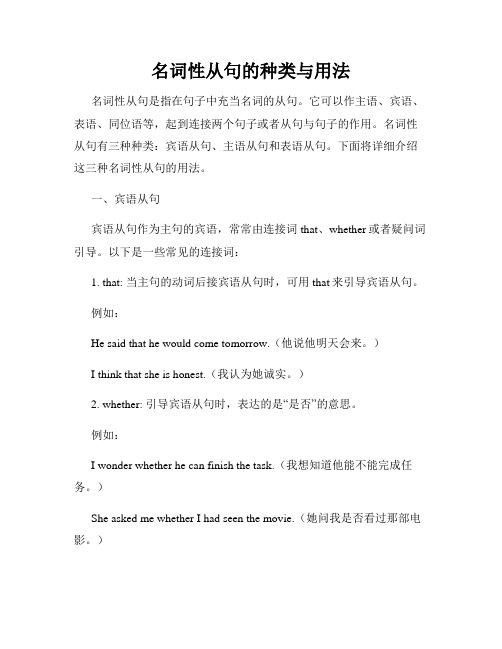
名词性从句的种类与用法名词性从句是指在句子中充当名词的从句。
它可以作主语、宾语、表语、同位语等,起到连接两个句子或者从句与句子的作用。
名词性从句有三种种类:宾语从句、主语从句和表语从句。
下面将详细介绍这三种名词性从句的用法。
一、宾语从句宾语从句作为主句的宾语,常常由连接词that、whether或者疑问词引导。
以下是一些常见的连接词:1. that: 当主句的动词后接宾语从句时,可用that来引导宾语从句。
例如:He said that he would come tomorrow.(他说他明天会来。
)I think that she is honest.(我认为她诚实。
)2. whether: 引导宾语从句时,表达的是“是否”的意思。
例如:I wonder whether he can finish the task.(我想知道他能不能完成任务。
)She asked me whether I had seen the movie.(她问我是否看过那部电影。
)3. 疑问词(who, what, where, when, why, how等): 疑问词既可以引导宾语从句,又可以引导特殊疑问句。
例如:I don't know what he is doing.(我不知道他在做什么。
)Could you tell me where the library is?(你能告诉我图书馆在哪里吗?)二、主语从句主语从句在句子中作主语,常常由连接词that或者疑问词引导。
以下是一些常见的连接词:1. that: 当主句的动词是think, believe, hope, guess, know等,常常用that来引导主语从句。
例如:That he is the best candidate is beyond doubt.(他是最好的候选人是毫无疑问的。
)It is not certain that he will win the game.(他能否赢得比赛尚不确定。
名词性从句的用法

名词性从句的用法名词性从句是在句子中充当名词的成分的从句。
名词性从句可以作为主语、宾语、表语或补语,常见的名词性从句有宾语从句、主语从句、表语从句和同位语从句。
1. 宾语从句(Object Clause):宾语从句在主句中充当宾语的角色。
一般引导宾语从句的词包括that, whether, if, why, how, when, where, who, whom 等。
示例:I don't know where he lives.(我不知道他住在哪里。
)2. 主语从句(Subject Clause):主语从句在句子中充当主语的角色。
常用的引导词有that, whether, if, what, who, which, where, how 等。
示例:What she said surprised me.(她说的话让我很惊讶。
)3. 表语从句(Predicate Nominative Clause):表语从句在句子中充当表语的角色。
一般由连词that 或whether 引导,也可以由who, whom, whose, which 等引导。
示例:His dream is that he can become a famous singer.(他的梦想是成为一名著名的歌手。
)4. 同位语从句(Appositive Clause):同位语从句用来解释、说明和限制先行词的意义。
它与先行词之间往往用连词that 或whether 连接。
示例:The news that he had won the prize made everyone happy.(他获奖的消息让大家都很高兴。
)。
名词性从句(宾语表语从句)

who/what/where等特殊疑问词在表语从句中充 当成分,表示疑问。
例句
The question who did it remains unanswered. (是谁做的这件事仍然是个谜。)
注意
特殊疑问词引导的表语从句必须要有明确的疑问 对象,不能省略。
06
表语从句的时态和语序
表语从句的时态
在时、过去时或将来时,但通常以现在时为主。
03
如果主句的时态是过去时,宾语从句的时态可以是过
去时、过去完成时或过去进行时。
宾语从句的语序
宾语从句的语序通常是陈述句语序,即主语+谓语的顺序。
在宾语从句中,如果需要使用疑问词引导,疑问词应放在句首,其余部分仍采用陈述句 语序。
例如,“我不知道他什么时候回来”可以表达为“I don't know when he will come back”。在这个例子中,“when”是疑问词,放在句首,其余部分“he will come
包含一个主句和一个或多个从句,从句本源自包含一个或多个修饰成分。02
宾语从句的引导词
that的用法
定义
that在宾语从句中不充当任何成分,仅起连接作用。
例句
The news that he will be promoted is true.(他将 升职的消息是真的。)
注意
在非正式文体或口语中,that常被省略。
当前时间点的时态
当主句描述的是当前时间点的状 态或事实时,表语从句通常使用 一般现在时。例如:“The problem is (that) he doesn't understand the instructions.” (问题是他不懂指示。)
名词性从句中的主语从句与宾语从句
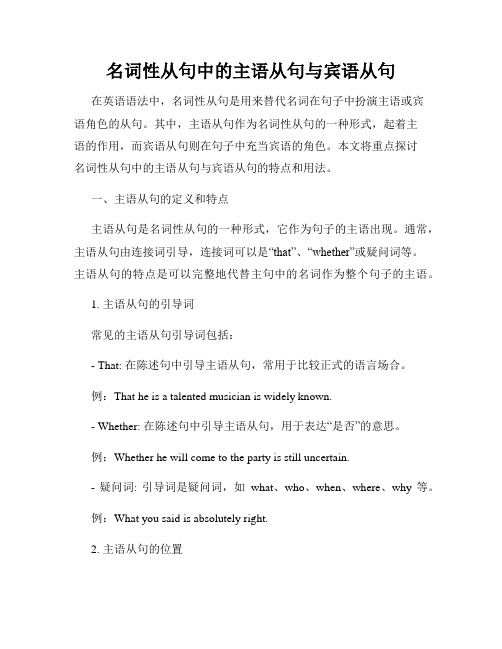
名词性从句中的主语从句与宾语从句在英语语法中,名词性从句是用来替代名词在句子中扮演主语或宾语角色的从句。
其中,主语从句作为名词性从句的一种形式,起着主语的作用,而宾语从句则在句子中充当宾语的角色。
本文将重点探讨名词性从句中的主语从句与宾语从句的特点和用法。
一、主语从句的定义和特点主语从句是名词性从句的一种形式,它作为句子的主语出现。
通常,主语从句由连接词引导,连接词可以是“that”、“whether”或疑问词等。
主语从句的特点是可以完整地代替主句中的名词作为整个句子的主语。
1. 主语从句的引导词常见的主语从句引导词包括:- That: 在陈述句中引导主语从句,常用于比较正式的语言场合。
例:That he is a talented musician is widely known.- Whether: 在陈述句中引导主语从句,用于表达“是否”的意思。
例:Whether he will come to the party is still uncertain.- 疑问词: 引导词是疑问词,如what、who、when、where、why等。
例:What you said is absolutely right.2. 主语从句的位置主语从句通常位于句子的开头或中间位置,前面可以有一些描述性的词语或状语从句。
例:It is important that we protect the environment.三、宾语从句的定义和特点宾语从句是名词性从句的另一种形式,它作为句子的宾语出现。
与主语从句不同,宾语从句不能独立存在,而是作为动词的宾语出现。
宾语从句的特点是可以完整地替代主句中的名词作为动词的宾语。
1. 宾语从句的引导词常见的宾语从句引导词包括:- That: 在陈述句中引导宾语从句,最常见且用法最广。
例:She said that she would come to the party.- Whether: 在陈述句中引导宾语从句,表示“是否”。
高中英语知识点归纳名词性从句与宾语从句的区别

高中英语知识点归纳名词性从句与宾语从句的区别名词性从句和宾语从句是英语语法中常见的两种从句类型。
虽然它们都是从句,但在使用和功能上有一些区别。
本文将从几个方面介绍名词性从句和宾语从句的区别。
一、定义与功能名词性从句是在一个句子中充当名词的从句,它可以在句子中作主语、宾语、表语等。
名词性从句具有引导词,如that, whether, who, what, which等。
宾语从句是在一个句子中作宾语的从句,它通常由动词表示的动作或者状态所需的内容构成,相当于一个名词。
二、引导词的不同名词性从句和宾语从句在引导词上有所不同。
1. 名词性从句的引导词包括that, whether, who, whom, whose, what, which等.例如:- I think that he is a good student.(that引导名词性从句)- I don't know whether he will come or not. (whether引导名词性从句)- She is the one who helped me yesterday.(who引导名词性从句)2. 宾语从句的引导词通常是连接代词that, whether等,以及疑问词who, whom, whose, what, which等。
例如:- I heard that he is a good student. (that引导宾语从句)- I wonder whether he will come or not.(whether引导宾语从句)- Do you know who helped me yesterday?(who引导宾语从句)三、位置和用法名词性从句和宾语从句在使用上也有一些区别。
1. 名词性从句可以出现在句子中的任何位置,而宾语从句通常出现在及物动词的宾语位置。
例如:- I know that he is a good student. (名词性从句作宾语)- He told me that he is a good student.(名词性从句作间接宾语)- I wonder whether he will come or not.(宾语从句)2. 名词性从句可以通过改变词性来转换成宾语从句。
初中英语语法专题四: 名词性从句之宾语从句(PDF版)

专题四宾语从句在英语中,名词或名词短语主要充当四种句子成分:主语、宾语、表语和同位语。
如果把句子当作名词来用,分别充当另一句话的主语、宾语、表语或同位语,于是便构成了四种从句:主语从句、宾语从句、表语从句和同位语从句。
因为这四种从句在本质上相当于名词的作用,所以将其统称为名词性从句。
相当于名词作用的句子有三类:陈述句、一般疑问句以及特殊疑问句。
因此,名词从句可简单概括为这样一句话:名词从句就是用三种句子来分别充当另外一个句子的四种句子成分,这构成了名词从句的本质特征。
一、要在陈述句句首加上that:对于陈述句,连接词that是后来添加上去的,此时的that自然不充当从句里的任何成分,而且也没有任何意义,只起连接主句和从句的作用。
二、一般疑问句作句子成分用whether或if引导:当把一般疑问句当作名词来使用时,需要先将疑问句的倒装语序变成陈述句语序,并在句首加上whether或if(if只用在宾语从句中)来引导,以保留原句的疑问意义。
对于一般疑问句,连接词whether也是后来添加上去的,目的是为了保留疑问的意义,表示“是否”,即whether 是有意义的,这不同于that。
而与that相同的是,whether也不充当任何句子成分。
三、特殊疑问句作句子成分变倒装语序为陈述语序;特殊疑问词作主语,无需调整句子语序:对于特殊疑问句,不需要添加任何连接词,因为特殊疑问词就充当了连词的作用,从而变成了相应的连接词,只需要把倒装语序还原成陈述语序就可以了。
在初中阶段,我们只讨论四种从句中的宾语从句,其余三种从句我们会在高中阶段学习。
宾语从句名词性从句的本质是用三种句子充当四种句子成分。
所以,当用三种句子(陈述句、一般问句和特殊问句)充当另外一个句子谓语动词、介词或某些形容词的宾语时,就构成了宾语从句。
宾语从句三部曲:1.引导宾语从句的连词和代词选择; 2.宾语从句的语序; 3.宾语从句的时态。
Ⅰ.宾语从句的引导词一、陈述句作宾语“that+陈述句”这一结构充当宾语构成宾语从句注意:只有宾语从句中的that才可以省去例:We know(that)the world is round.我们知道,地球是圆的。
名词性从句与宾语从句的特点

名词性从句与宾语从句的特点名词性从句和宾语从句是英语语法中的两个重要概念。
它们作为从句的一种形式,在句子中充当名词的角色,具有一些独特的特点。
本文将重点讨论名词性从句和宾语从句的特点以及它们在句子中的应用。
一、名词性从句的特点名词性从句是指在句子中充当名词的从句,可以作主语、宾语、表语或同位语。
它的特点主要包括以下几点:1. 引导词多样化:名词性从句由引导词引出,常见的引导词有“that, whether, who, whom, which, what, whoever, whatever”等。
根据引导词的不同,从句的性质也会有所区别。
2. 与主句之间的关系紧密:名词性从句与主句之间存在着密切的依存关系,在句子中起到承上启下的作用。
它与主句一起构成了一个完整的句子结构。
3. 可以替代成一个名词:名词性从句本身具备了名词的功能,可以在句子中担任主语、宾语、表语等角色。
通过名词性从句,我们可以避免重复使用某个名词,使句子更加简洁明了。
二、宾语从句的特点宾语从句是指在句子中充当宾语的从句,它的特点与名词性从句有一些相似之处,但也存在一些独特的特点:1. 位于及物动词或介词后:宾语从句通常出现在及物动词或介词后,起到补充说明的作用。
例如,“I know that he is coming.”中的“that he is coming”就是作为动词“know”的宾语从句。
2. 可以被替代成一个名词:宾语从句的最大特点就是它可以替代成一个名词。
它可以作为整个句子的宾语,承担句子的核心意义,使句子更加丰富和灵活。
3. 句子成分完整:宾语从句是一个完整的句子结构,包括主语、谓语和宾语等成分。
和名词性从句一样,宾语从句也与主句之间存在着紧密的联系。
三、名词性从句与宾语从句的差异名词性从句和宾语从句虽然在某些方面有所相似,但它们也有一些明显的差异:1. 引导词不同:名词性从句的引导词较多,包括“that, whether, who, whom, which, what, whoever, whatever”等,而宾语从句的引导词主要是“that, whether, if”。
名词性从句的三种类型及例句解析
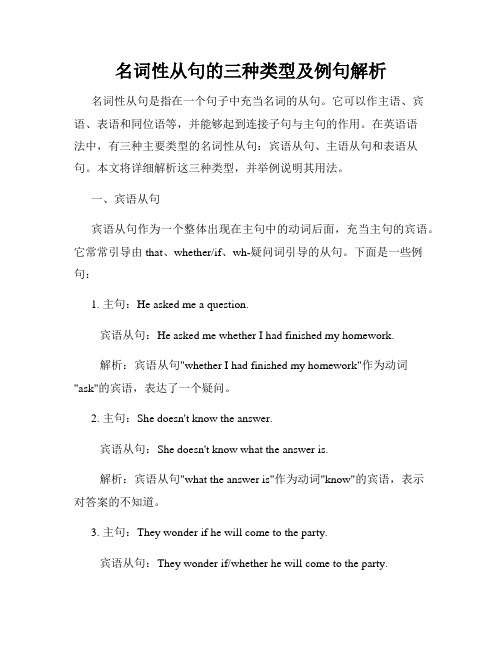
名词性从句的三种类型及例句解析名词性从句是指在一个句子中充当名词的从句。
它可以作主语、宾语、表语和同位语等,并能够起到连接子句与主句的作用。
在英语语法中,有三种主要类型的名词性从句:宾语从句、主语从句和表语从句。
本文将详细解析这三种类型,并举例说明其用法。
一、宾语从句宾语从句作为一个整体出现在主句中的动词后面,充当主句的宾语。
它常常引导由that、whether/if、wh-疑问词引导的从句。
下面是一些例句:1. 主句:He asked me a question.宾语从句:He asked me whether I had finished my homework.解析:宾语从句"whether I had finished my homework"作为动词"ask"的宾语,表达了一个疑问。
2. 主句:She doesn't know the answer.宾语从句:She doesn't know what the answer is.解析:宾语从句"what the answer is"作为动词"know"的宾语,表示对答案的不知道。
3. 主句:They wonder if he will come to the party.宾语从句:They wonder if/whether he will come to the party.解析:宾语从句"if/whether he will come to the party"作为动词"wonder"的宾语,表达了对他是否会来参加派对的疑问。
二、主语从句主语从句作为一个整体出现在句子的最前面,充当主句的主语。
它通常由that引导,也可以由wh-疑问词引导。
以下是一些例句:1. 主句:It is important to learn a foreign language.主语从句:That she is a hardworking student is important.解析:主语从句"That she is a hardworking student"作为句子的主语,强调了她是一个勤奋的学生的重要性。
名词性从句之宾语从句和表语从句

引导词
要点一
总结词
表语从句的引导词包括that、whether、what、who、 whose等。
要点二
详细描述
that是最常用的引导词,用于引导描述性或解释性的表语从 句,如"The fact is that we won the game."(事实是我们 赢了比赛)。whether用于引导表示选择或疑问的表语从句, 如"The question is whether we should go or stay."(问 题是我们要走还是留下)。what用于引导含有疑问代词的表 语从句,如"The problem is what we should do next." (问题是接下来我们应该做什么)。who和whose用于引导 含有疑问代词的表语从句,如"The question is who should be responsible for the project."(问题是应该由谁负责这 个项目)。
03 从句与主句的关系
主从关系
主句是整个句子的核心,从句作为主句的延伸或补充,对主句进行解释、说明或 修饰。
从句在句子中的位置通常紧跟在主句之后,用连词引导,如“that”、“what” 、“when”等。
嵌套关系
嵌套关系是指一个从句内部又包含另 一个从句,即从句中又套有另一个从 句。
嵌套从句通常用于表达复杂的概念或 描述某种逻辑关系,使句子更加丰富 和多样。
名词性从句之宾语从句 和表语从句
目录
Contents
• 宾语从句 • 表语从句 • 从句与主句的关系 • 从句的省略形式
01 宾语从句
定义
01
宾语从句是名词性从句的一种, 在句子中充当宾语成分。
专题四 名词性从句之宾语从句
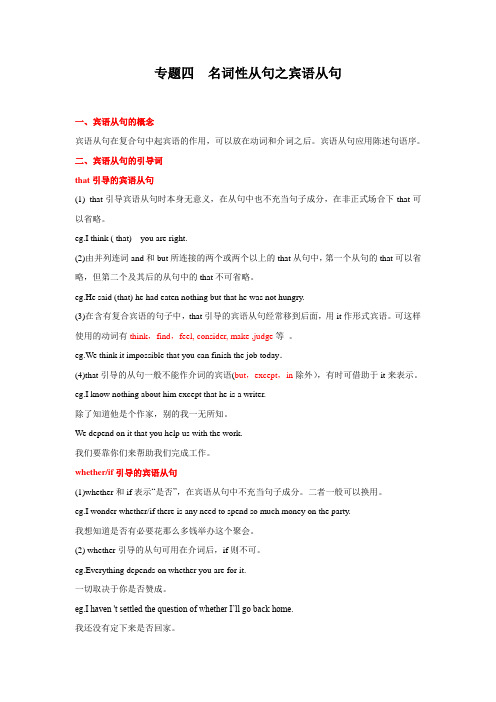
专题四名词性从句之宾语从句一、宾语从句的概念宾语从句在复合句中起宾语的作用,可以放在动词和介词之后。
宾语从句应用陈述句语序。
二、宾语从句的引导词that引导的宾语从句(1) that引导宾语从句时本身无意义,在从句中也不充当句子成分,在非正式场合下that可以省略。
eg.I think ( that) you are right.(2)由并列连词and和but所连接的两个或两个以上的that从句中,第一个从句的that可以省略,但第二个及其后的从句中的that不可省略。
eg.He said (that) he had eaten nothing but that he was not hungry.(3)在含有复合宾语的句子中,that引导的宾语从句经常移到后面,用it作形式宾语。
可这样使用的动词有think,find,feel, consider, make ,judge等。
eg.We think it impossible that you can finish the job today.(4)that引导的从句一般不能作介词的宾语(but,except,in除外),有时可借助于it来表示。
eg.I know nothing about him except that he is a writer.除了知道他是个作家,别的我一无所知。
We depend on it that you help us with the work.我们要靠你们来帮助我们完成工作。
whether/if引导的宾语从句(1)whether和if表示“是否”,在宾语从句中不充当句子成分。
二者一般可以换用。
eg.I wonder whether/if there is any need to spend so much money on the party.我想知道是否有必要花那么多钱举办这个聚会。
(2) whether引导的从句可用在介词后,if则不可。
名词性从句之宾语从句与表语从句

back tomorrow. ❖He said that he __h_a_d__s_ee_n__(see) it .
the sun.
4.从句中有具体时间状语,即使从句动作 发生在主句动作前,仍用一般过去时。
• The boss told me he was born in 1960.
• I heard that he went to Paris last night.
Summary (小结)
宾语从句 三要素
引导词(连接词) 语序 时态
eg: I don’t know what’s the matter.
做主语
Can you tell me who is over there? Can you tell me who he is ?
做表语
否定的转移
若主句谓语动词为think, consider, suppose, believe, expect, guess, imagine等,
二、宾语从句三要素
引导词(连接词) 语序 时态
(一)引导词
1 从属连词 that, whether, if 2 连接代词 who,whom,whose,which,what 3 连接副词 where,how,why,when
由从属连词 that 引导的宾语从句
注:that 在句中无词汇意义,在从句中不 充当成分,在口语当中往往省略
名词性从句之宾语从句课件高三英语一轮复习(1)

People say that Jesse Owens was one of the most important athletes of the 20th Century.
宾语从句三要素:
引导词,时态,语序
宾语从句的引导词:
that, whether, if; what ,who, whom,whose; when, where, how, why;
Where
People began looking across to see where the noise was coming from.
He knew where Henry Carter had gone.
Ernest Brown lives about a dozen blocks from where the riots began.
years. • It's funny how I never seem to get a thing done on my
day off. • It's important to become acutely aware of how your
eating ties in with your stress level.
• {subject} + does something to + {object}
• Jesse Owens + won + 4 gold medals.
• I + believe + your sister.
• The objects in these two examples above are two noun phrases: 4 gold medals and your sister.
名词性从句与宾语从句的区别及例句解析
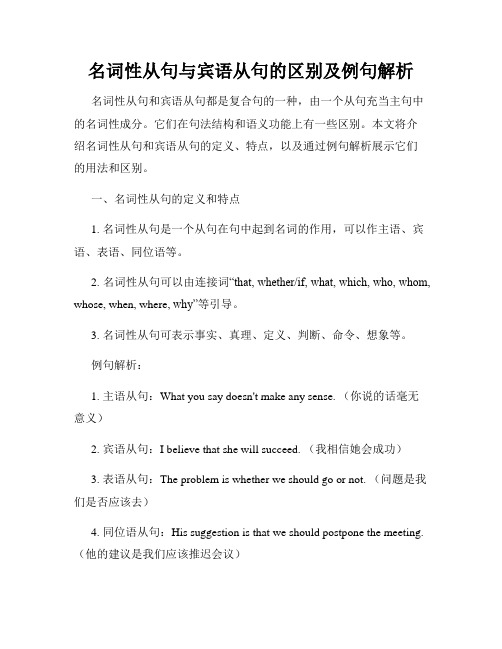
名词性从句与宾语从句的区别及例句解析名词性从句和宾语从句都是复合句的一种,由一个从句充当主句中的名词性成分。
它们在句法结构和语义功能上有一些区别。
本文将介绍名词性从句和宾语从句的定义、特点,以及通过例句解析展示它们的用法和区别。
一、名词性从句的定义和特点1. 名词性从句是一个从句在句中起到名词的作用,可以作主语、宾语、表语、同位语等。
2. 名词性从句可以由连接词“that, whether/if, what, which, who, whom, whose, when, where, why”等引导。
3. 名词性从句可表示事实、真理、定义、判断、命令、想象等。
例句解析:1. 主语从句:What you say doesn't make any sense. (你说的话毫无意义)2. 宾语从句:I believe that she will succeed. (我相信她会成功)3. 表语从句:The problem is whether we should go or not. (问题是我们是否应该去)4. 同位语从句:His suggestion is that we should postpone the meeting. (他的建议是我们应该推迟会议)二、宾语从句的定义和特点1. 宾语从句是一个从句在句中作动词的宾语。
2. 宾语从句可以由连接词“that, whether/if, what, which, who, whom, whose, when, where, why”等引导。
3. 宾语从句的动词可以是任何及物动词,通常是表示思想、感觉、说话、知觉等动词。
例句解析:1. He asked me what time it was. (他问我现在几点了)2. She wonders whether/if she should accept the job. (她在考虑是否接受这份工作)3. Can you tell me where the nearest post office is? (您能告诉我最近的邮局在哪里吗)4. I don't know why he didn't come to the party. (我不知道他为什么没有来参加派对)三、名词性从句和宾语从句的区别1. 引导词的不同:名词性从句可以由多种连接词引导,而宾语从句通常由连接词“that, whether/if, what, which, who, whom, whose, when, where, why”等引导。
名词性从句之宾语从句
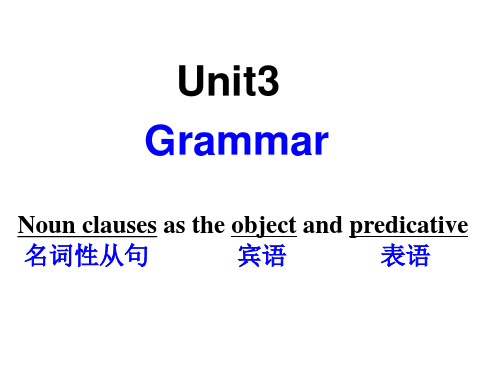
He told me the earth __m_o__v_e_s (move) around the sun.
3. 从句说明的是一般真理、客观事实、自然现 象时, 仍用一般现在时。
• The teacher told me she w__a_s_ (be) born in 1960. • I heard that shew__e_n_t (go) to Paris last night.
whose son he is. what he does in…. why he is alone.
一些特殊疑问词如what, who等在宾语从句中 作主语时,语序不变:
What’s wrong? What’s the matter? What has happened? Who is in the classroom? Which is the way to the station?
3.主句+what等疑问词+从句 4.动词+it+形容词或惯用搭配+that从句
1.that引导的宾语从句
1) I hear that he will be back in a month. 2) Everybody could see what happened and that Tom was frightened. 3) I know nothing about him except that he is living in Beijing. 4) We made it clear that we would not give in.
So ;not代替宾语从句
在think,believe,imagine,suppose,guess,hope等 动词以及 I’m afraid 等后,可用so代替一个肯定的宾语 从句,还可用not代替一个否定的宾语从句: e.g. 一Do you believe it will clear up?你认为天气会转晴吗?
名词性从句与宾语从句
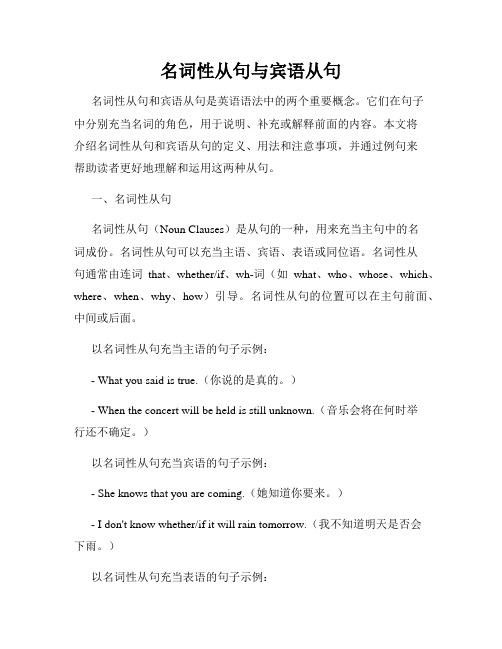
名词性从句与宾语从句名词性从句和宾语从句是英语语法中的两个重要概念。
它们在句子中分别充当名词的角色,用于说明、补充或解释前面的内容。
本文将介绍名词性从句和宾语从句的定义、用法和注意事项,并通过例句来帮助读者更好地理解和运用这两种从句。
一、名词性从句名词性从句(Noun Clauses)是从句的一种,用来充当主句中的名词成份。
名词性从句可以充当主语、宾语、表语或同位语。
名词性从句通常由连词that、whether/if、wh-词(如what、who、whose、which、where、when、why、how)引导。
名词性从句的位置可以在主句前面、中间或后面。
以名词性从句充当主语的句子示例:- What you said is true.(你说的是真的。
)- When the concert will be held is still unknown.(音乐会将在何时举行还不确定。
)以名词性从句充当宾语的句子示例:- She knows that you are coming.(她知道你要来。
)- I don't know whether/if it will rain tomorrow.(我不知道明天是否会下雨。
)以名词性从句充当表语的句子示例:- The problem is that he doesn't understand.(问题在于他不懂。
)- Her dream is to become a doctor.(她的梦想是成为一名医生。
)以名词性从句充当同位语的句子示例:- The fact that she passed the exam surprised everyone.(她通过了考试的事实让每个人都感到惊讶。
)- His belief that honesty is the best policy is admirable.(他认为诚实是最好的策略的信念令人钦佩。
名词性从句-宾语从句

名词性从句宾语从句名词性从句:是指在复合句中的作用相当于名词的从句。
包括:宾语从句,主语从句,表语从句和同位语从句四种从句宾语从句一.定义: 在复合句中作宾语的句子, 通常放在主句谓语动词(及物动词)或介词之后。
(注意仍然是找出两个动词)I don’t think so.↓I don’t think(that)it’s very funny.(宾语从句)I think (that) she is beautiful .I heard (that )he joined the army.I didn’t know whether I could survive until morning.I’m afraid (that) I don’t quite follow you, sir.May I ask you how much money you have?二.学习宾语从句应该注意的问题(宾语从句高考考查主要内容):1.引导词(连接词)的选择与判断;2.语序:不倒装(陈述句语序);3.时态:注意主、从句时态的呼应1.连接词:引导词连接词:that, whether, if连接疑问代词who,whom, whose, which ,what连接疑问副词:when、where、why、how等宾语从句是:(1)主句的谓语动词通常是及物动词(可以直接接物坐宾语的动词),这样才可以接有宾语从句。
He askedwhose spacesuit it is.Will you tellme how I can keep fit and healthy?(2)宾语从句是陈述句:He is a student.他是个学生。
(主+系+表)放在宾语从句中后→→He says(that)he is a student_ (他说他是个学生。
)Where did he lose his wallet? 放在宾语从句中后→→He didn’t know where he lost his wallet. (主+谓+ 宾)小结:陈述句的宾语引导词用——(that)无词义,可以省略,但是其它的引导词不可以省。
名词性从句之宾语从句及表语从句公开课课件

01
下列句子中,哪一个不是宾
语从句?
02
03
在"I think that he will come"中,that引导的是哪
一种从句?
04
05
下列从句中,哪一个是从句 可以省略引导词?
填空题练习
总结词:检验知识运用能力
01
02
练习题目
请在下列句子中填入合适的连词,使之成 为正确的宾语从句。
03
04
例:(When) you finish your homework, you can watch TV.
名词性从句之宾语从句及表 语从句公开课课件
目录
• 名词性从句的概述 • 宾语从句的详解 • 表语从句的详解 • 宾语从句与表语从句的区别与联
系 • 练习与巩固 • 总结与回顾
01
名词性从句的概述
定义
01
02
03
名词性从句
在句子中起名词作用的句 子,用来充当主语、宾语 、表语和同位语。
宾语从句
在句子中充当宾语的名词 性从句,通常出现在动词 或介词之后。
用法
陈述句作宾语从句
使用陈述句表达一个完整 的思想,在主从复合句中 充当宾语。
疑问句作宾语从句
使用疑问句表达一个不完 整的思想,在主从复合句 中充当宾语。
虚拟语气
在某些特定语境下,使用 虚拟语气表达与事实相反 的情况。
注意事项
时态一致
宾语从句的时态要与主句时态保 持一致。
语序不变
宾语从句的语序不变,即疑问词 +助动词+主语+谓语的语序。
注意事项三
注意时态问题,表语从句的时态要与主句时态保 持一致。
名词性从句和宾语从句的区别和联系

名词性从句和宾语从句的区别和联系名词性从句和宾语从句是英语语法中常见的两种从句。
虽然它们都属于从句的一种,但在用法和功能上存在着一些区别和联系。
本文将探讨名词性从句和宾语从句的特点、用法以及它们之间的联系。
一、名词性从句的特点和用法名词性从句是指在句子中充当名词的从句,在句子中可以作主语、宾语、表语或补语。
名词性从句通常由连接词引导,常见的连接词有:that, whether, if, who, whom, which, what, when, where, why等。
名词性从句的主要特点如下:1. 充当句子的某一成分,如主语、宾语等;2. 可以独立成句,有自己的主谓结构;3. 通常由连接词引导;4. 位置比较灵活,可以出现在句子的任何位置。
下面以一些例句说明名词性从句的用法:1. 主语从句:- What she said is true.(她说的是真的。
)- Whether he will come is still uncertain.(他是否会来还不确定。
)2. 宾语从句:- I don't know where he lives.(我不知道他住在哪里。
)- She asked me what my favorite color was.(她问我最喜欢的颜色是什么。
)3. 表语从句:- The important thing is that we have tried our best.(重要的是我们已经尽力了。
)- The fact is that he lost his job.(事实是他丢了工作。
)二、宾语从句的特点和用法宾语从句是指在句子中充当宾语的从句,在句子中通常作及物动词或介词的宾语。
宾语从句可以由连接词引导,常见的连接词有:that, whether, if, who, whom, which, what等。
宾语从句的主要特点如下:1. 充当句子的宾语;2. 通常由连接词引导,连接词常被省略;3. 位置相对固定,通常出现在及物动词或介词后面。
名词性从句和宾语从句的区别与应用

名词性从句和宾语从句的区别与应用名词性从句与宾语从句是英语语法中的两个重要概念,它们在句子结构和用法上有一些区别。
本文将分析名词性从句和宾语从句的区别,并探讨它们在实际应用中的具体用法。
一、名词性从句的概念和特点名词性从句是在句中充当名词的从句,可以用作主语、宾语、表语、同位语等。
它的特点是在从句中包括一个连接词以引导从句,并在句中充当特定的语法角色。
1. 名词性从句作主语的用法:- What he said is true.(宾语从句作主语)- Whether she will come is still uncertain.(宾语从句作主语)- If it rains, we will stay at home.(条件从句作主语)2. 名词性从句作宾语的用法:- I know what you did last summer.(宾语从句作宾语)- He asked me where I was going.(宾语从句作宾语)- They wonder if the movie is worth watching.(宾语从句作宾语)3. 名词性从句作表语的用法:- His answer is what surprised me.(宾语从句作表语)- The problem is whether we can solve it.(宾语从句作表语)- The fact that she succeeded is well-known.(宾语从句作表语)4. 名词性从句作同位语的用法:- The idea that he proposed is worth considering.(宾语从句作同位语)- His belief that hard work brings success is widely accepted.(宾语从句作同位语)二、宾语从句的概念和特点宾语从句是在句中充当宾语的从句,通常由连接词引导。
- 1、下载文档前请自行甄别文档内容的完整性,平台不提供额外的编辑、内容补充、找答案等附加服务。
- 2、"仅部分预览"的文档,不可在线预览部分如存在完整性等问题,可反馈申请退款(可完整预览的文档不适用该条件!)。
- 3、如文档侵犯您的权益,请联系客服反馈,我们会尽快为您处理(人工客服工作时间:9:00-18:30)。
(think/find/consider/make /believe/feel)
1. We think ___ it necessary for us to learn English. 2. We think ___ it necessary ___ that_______________. we should learn English. 3. I feel ___ it an honour ____ that I have been invited.
____+表事实的从句 that _______表疑问的从句 wh-/how 连词后均用陈述 _____语序
把这4个句子放在适当的空白处 一:宾语从句 1. Tiger is a good teacher. 2. Is Tiger a good teacher? 3. What is Tiger doing now? 4. How long will he stay here? I know __________________________. that Tiger is a good teacher I was asked ____________________________ whetherБайду номын сангаасTiger is a good teacher . what Tiger is doing now I wonder ________________________________. I am not sure about _____________________________ . how long he will stay here
D. 动词 + 介词(短语) + it + that从句。 常见于answer for, depend on, rely on, insist on, look to, see to, stick to 等结构中。
1. I'll see to it that everything is ready in time. 2. You may depend on it that Tom will help you with your English. 3. I'm counting on it that you will come.
名词性从句
Grammar
名词性从句之…
表语从句 宾语从句 主语从句 同位语从句
复合句=主句+从句
名词性从句
副词性从句
形容词性从句
表语从句 宾语从句 主语从句 同位语从句
句 子作表语, 宾语,主语和同 位语相当于名词
状语语从句
句 子作状语
相当于副 词
引导从 句的两 类连词
定语从句
句 子作定语
相当于形容词
1. They didn’t say ______________________________. what they wanted 他们没有说他们想要什么。 2. I don’t know ____________________________________. where she has gone/where she is 我不知道她去哪里了。 that his dad has gone to Beijing. 3. He said __________________________________________. 他说他父亲去北京了。 that the earth travels around the sun 4. She told me ________________________________. 他告诉我地球围绕太阳旋转。 5. He asked ________________________________. how he could get his courage 他问道他如何才能找到他的勇气。 6. Tell me _____________________________________. which one do you like best 告诉我你最喜欢哪一个。
常见接宾语从句的词 1. V+宾语从句 2. V+sb+宾语从句 3. V+介词/副词+宾语从句 4. 介词+wh-/how引导的宾语从句 5. 形容词+宾语从句
that
wh-/how
'it' used as formal object (形式宾语)
A: 主语+V. +it +adj./n. + that clause(/V-ing/ to do…)
B. 动词+ it + that从句。常见于like, take, have, put等少数 动词之后(it相当于that从句的同位语)。
1. I take it that they will succeed sooner or later. 2. The newspapers have it that some Japanese firms have gone bankrupt. 3. Rumor has it that Mary is getting married. 4. I take it that you have been out. 5. Let me come and stay. You can put it that it was arranged before.
C. 动词 + it + 介词短语 + that从句。常见于 bring it to one's attention; owe it to sb; take it for granted 等结构中。
1. I owe it to you that I finished my work in time. 2. Don't take it for granted that they will support you.
'it' used as formal object (形式宾语)
B: I hate, dislike it if (when)... I appreciate, enjoy, like, dislike, love, prefer it if (when)...
1. We would much appreciate it if you could do us that favour. 2. I'd prefer it if I didn't have to finish the work.
